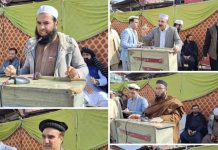Mohammad Shafique
Technically, inclusion is a powerful word that includes young and old, rich and poor and white and black under a shadow. It shows people’s contributions and relations with each other in a diverse community. In late 1980, the concept of social inclusion was adopted by the European Union as a key concept of social policy, because the term social inclusion has been an economic element, which is associated with poverty (Omidvar and Richmond, 2003). However, compared to Europe and Australia, it is a new concept in North America, particularly in Canada. Social inclusion is defined as; a response to the individual’s previous social life and a notion of belonging, acceptance, and recognition (Journal of Senate, 2013). The World Bank defined social inclusion as “the process of improving the terms on which individuals and the group take part in society, improving the ability, opportunity, and dignity of those disadvantaged based on their identity to take part in society” (World Bank, 2013, P. 1).
Migration and settlement in a new country remain among the most challenging experiences for individuals and families. For many immigrants, particularly Afghan newcomers, adapting to Canadian society involves navigating complex social, economic, and cultural landscapes. While Canada promotes inclusion through multiculturalism and citizenship policies, immigrants continue to face significant barriers that can delay their integration.
This article explores the journey of recently arrived Afghan immigrants in Canada, focusing on their efforts to integrate and the obstacles they face, including language barriers, racism, economic hardship, and religious inclusion.
Literature and Context
Scholars Omidvar and Richmond (2003) define social inclusion as a sense of belonging, recognition, and equal opportunity. Although Canada’s Charter of Rights and Freedoms guarantees equality, many newcomers experience exclusion in education, employment, and community participation. Clutterbuck and Novick (2003) argue that social inclusion must go beyond policy, requiring practical efforts to build equitable cities where newcomers feel valued and engaged.
Omidvar and Richmond make three important observations: 1) Experiences of inclusion vary by location and background, 2) diversity is a demographic fact, while inclusion is a deliberate process, and 3) inclusion requires leadership and clear strategies.
Integration Through Children’s Experiences
Newcomer children often face significant hurdles adjusting to Canadian classrooms. Language is a primary challenge. When my daughter Rabia arrived in 2017, she couldn’t speak English. Her teacher noted she was shy and disengaged. Months later, she began participating more, eventually becoming fluent and socially confident. However, her siblings, who arrived at older ages, took longer to adapt. Research confirms that younger children generally integrate faster into school systems and adopt new cultural norms more readily.
Libraries as Social Hubs
Public libraries play a crucial role in newcomer integration. My own experience in 2014 at the Thorncliffe Park Library illustrates this. Isolated and unfamiliar with Canadian society, I found friendship and community at the library. These spaces offer access to resources, social programs, and vital information, especially during the early months when newcomers lack stable housing or employment.
Kennan et al. (2011) and John, Larissa, and Allan (2018) describe libraries as trusted, inclusive environments where newcomers can build networks, find help, and feel part of the broader community.
Cultural Enclaves and Belonging
Cultural enclaves like Toronto’s Thorncliffe Park serve as landing zones for newcomers, particularly South Asians and Afghans. These areas provide cultural familiarity, including halal food, mosques, and a shared language. Bain (2008) and Kim (2009) emphasize that such spaces offer social cohesion and help reduce isolation during the initial integration phase.
Community-led initiatives, like the Thorncliffe Park Women’s Group, organize public events that celebrate culture and foster belonging. These efforts are a visible expression of inclusion and civic participation.
Barriers to Integration
Despite these positive experiences, Afghan immigrants continue to face serious challenges:
• Economic barriers: Many struggle to find employment matching their skills and education. Unemployment and underemployment are common among first-generation immigrants.
• Racism and discrimination: Ethnic stereotypes in schools and workplaces hinder social progress. Immigration status can also limit access to training or employment.
• Language: Limited English or French proficiency affects access to services, job opportunities, and social networks.
• Religious inclusion: While Canada is officially multicultural, Afghan Muslim families often face discomfort or discrimination, especially regarding Islamic practices and clothing. Few affordable religious schools exist, leaving low-income families without options.
Conclusion
As Omidvar (2011) notes, inclusion is everyone’s responsibility—teachers, neighbors, librarians, and employers all play a role. While Afghan newcomers are making efforts to integrate, systemic challenges persist. Addressing these requires ongoing community engagement, supportive policies, and recognition of the social capital that immigrants bring. Social inclusion should not be viewed as a one-time act but as a continuous process that enables immigrants to thrive and contribute meaningfully to Canadian society.
Mohammad Shafiq
Student of Ryerson University in Toronto, Canada.
Master of Social Science at Karlstad University, Sweden.
Disclaimer…
The content of this article is the personal opinion of the writer, and “FVNA” is not bound to agree or disagree with it.











